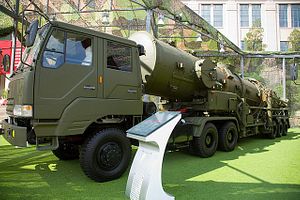Henry D. Sokolski, the executive director of the Nonproliferation Policy Education Center and former Pentagon official and consultant to the Office of Net Assessment, has written a thoughtful and sobering study on the potential for nuclear proliferation and competition in the Asia-Pacific region. Published in January 2016 by the U.S. Army War College Press, Underestimated: Our Not So Peaceful Nuclear Future, presents a bleak but not altogether hopeless view of current trends in the development of strategic, intermediate and battlefield nuclear weapons, the spread of ballistic missile technology, and the proliferation of nuclear weapons-grade material throughout the region.
This vision is not shared by most of the world’s policymakers and academic theorists who instead see the world becoming a safer place as the United States and Russia continue to reduce their stockpiles of nuclear weapons, nuclear deterrence becomes virtually “automatic,” and non-nuclear powers obtain “peaceful” nuclear facilities and materials. Sokolski argues that the more sanguine views of the nuclear future in the Asia-Pacific fail to “fully explore the regional insecurities that arise with threatened nuclear weapons breakouts or ramp-ups,” ignore the “significant overlaps between civilian and military nuclear activities or the risk that ‘peaceful’ nuclear facilities or materials might be diverted to make bombs,” and downplay the potential strategic instability that may result from U.S.-Russian nuclear disarmament in the face of nuclear weapons build-ups by China, India, Pakistan, and possibly other regional states, and the proliferation of nuclear facilities and materials.
If current trends continue, Sokolski explains, “[t]he strategic military competitions of the next . . . decades will be unlike any the world has yet seen.” At the height of the Cold War, the nuclear arsenals of the United States and Soviet Union dwarfed those of the world’s other nuclear powers. Today, while the U.S. and Russia freeze or continue to reduce their nuclear arsenals, China, India, and Pakistan are increasing and modernizing their strategic nuclear forces; which means that “the next arms race will be run by a much larger number of contestants with highly destructive strategic capabilities far more closely matched and capable of being quickly enlarged than in any other previous period in history.”
According to Sokolski, Russia currently fields 3600 strategic and tactical nuclear weapons, the U.S. has 2130, China has somewhere between 190 and 900, while India, Pakistan, England, France and Israel each field between 100 and 400. “[T]he difference in the numbers of nuclear deployments between the top and bottom nuclear powers. . .,” he writes, “has fallen at least two full orders of magnitude and is projected to decline even further.” Moreover, because of the spread of weapons-grade material and nuclear facilities, at least six other countries – Iran, Saudi Arabia, South Korea, Japan and Algeria – are considered “possible near-or mid-term nuclear weapons-ready states.” This means, writes Sokolski, that “the stool of nuclear deterrence will have many more legs that could give way in many more surprising ways than were possible a half-century ago.”
Other developments in this area provide additional reasons for concern. Russia and Pakistan have doctrinally indicated that they will use nuclear weapons first against opponents’ conventional forces. China is reconsidering its declared “no first use” policy. Russia, China, and North Korea have constructed or expanded underground nuclear complexes to both hide and protect nuclear forces. Twenty-four nations have acquired ballistic missile systems capable of delivering nuclear warheads.
Although much has been written about China’s rise as a global power and potential peer competitor to the United States, less attention has been paid to China’s growing nuclear arsenal and capabilities. Sokolski notes China’s efforts to modernize its nuclear-capable missiles; its production of sufficient weapons-grade plutonium and uranium to make as many as 1200 nuclear weapons; its development and deployment of ballistic missile submarines; its construction and deployment of the DF-41 ICBM; its deployment of multiple independently targetable warheads (MIRVs) on the DF-5 missiles; and its increased uranium enrichment capacity, which will enable China to build more than five hundred nuclear weapons per year by the year 2020. These trends threaten to undermine the effectiveness of the U.S. extended nuclear umbrella to Japan and South Korea, and cast doubts on America’s ability to protect Taiwan, the Philippines, Australia, and other allies in the region. That, in turn, could lead Japan and South Korea, and perhaps other vulnerable countries, to seek their own nuclear deterrent. “These trends,” Sokolski writes, “invite disorder. How much depends on how well the United States, Russia, China, and other key states deal with them.”
Sokolski recommends three broad approaches to reverse these trends:
1. Reassess and clarify China’s nuclear capabilities and shift nonproliferation and arms control efforts to the Asia-Pacific region.
2. Nuclear supplier states must adopt tougher nonproliferation standards and insist on better international safeguards related to the transfer of “peaceful” nuclear technology.
3. Be more proactive in anticipating and preventing nuclear proliferation developments.
Above all, those countries that seek to improve nuclear stability must avoid the pitfalls of diplomacy by inattention and repeated downplaying of nuclear risks that undermined lengthy but unsuccessful nonproliferation efforts with North Korea and Iran. Adding nuclear instability to a region already beset by geopolitical rivalries and flashpoints is a recipe for catastrophe.
Francis P. Sempa is the author of Geopolitics: From the Cold War to the 21st Century (Transaction Books) and America’s Global Role: Essays and Reviews on National Security, Geopolitics and War (University Press of America). He is also a contributor to Population Decline and the Remaking of Great Power Politics (Potomac Books). He has written on historical and foreign policy topics for Joint Force Quarterly, American Diplomacy, the University Bookman, The Claremont Review of Books, The Diplomat, Strategic Review, the Washington Times and other publications. He is an attorney, an adjunct professor of political science at Wilkes University, and a contributing editor to American Diplomacy.
































